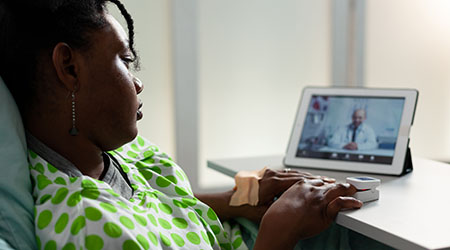The healthcare industry has undergone immeasurable challenges and changes throughout the last two years. Driven by the demands of the COVID-19 pandemic, the continued retailization of healthcare, and new research into delivering better outcomes, hospitals and healthcare systems are finding new ways to adapt to emerging pressures and best serve their patients, including updating the built environment. Here are four trends with perceived staying power and a discussion of the way they are impacting healthcare design and delivery.
Telemedicine impacts
While telemedicine was certainly becoming more common even before the pandemic, its usefulness and acceptance by the general public for routine follow-up appointments has been proven. When it comes to designing healthcare environments for telemedicine, one of the most important factors is ensuring the infrastructure can support the equipment and strains on internet broadband.
Privacy is first and foremost for any type of patient visit, but the space needs for an in-person visit and virtual visit differ. A telehealth visit will not require a full patient room, so dedicating more administrative space – like telemedicine stations, soundproof phone booths or even specific patient rooms for telehealth visits – can ensure that clinical space needed for in-person patients will be used that way. While current demand for telemedicine is manageable in existing designs, it is an area ripe for growth and one healthcare systems are keeping an eye on.
Cost and operating efficiency
While always a design-driver, maximizing efficiency seemed an especially distinctive thread running through the year. Hospitals are placing a strong emphasis on streamlining patient flow, reflecting a thoughtful approach to the way patients are guided through arrival, check-in and treatment in less time and with less confusion. More visible and accessible wayfinding has improved patient flow, and some hospital systems are experimenting with tech-enabled check-in kiosks, similar to an airport or office building, to improve the patient experience.
Similarly, the configuration of staffing areas and worker pathways demonstrated attention to minimizing overall labor needs and ensuring low staff footstep counts. The placement of resources throughout these corridors also has been logically optimized to support staff needs.
The pandemic experience had a clear influence on making healthcare environments easier to clean and maintain, most strikingly regarding materials specification. There was a pronounced move away from porous products, such as wood, and an increased focus on non-porous and anti-microbial surfaces, such as metals and plastics that can be sanitized more easily.
Hospitality design’s strong influence
The long-evolving trend away from the clinical and cold institutional facilities continues with today’s hospitality-influenced facilities. Just as hotels have developed a laser focus on every detail of the guest experience, healthcare designs are increasingly sensitive to each aspect of the patient journey, from check-in to discharge.
Warmer color palettes that are inviting and cheerful welcome patients and offer a sense of comfort and ease. Home-inspired furnishings and softer fabric selections with intricate patterns are being introduced, much to the delight of patients and guests. These design themes provide a welcome sense of comfort and relief to anxious patients.
Great outdoors
Longstanding research confirms that exposure to natural environments benefits the healing process, and healthcare designers continue to envision more opportunities to bring the outdoors into the patient experience.
Nondescript shrubs that once lined parking lots and healthcare buildings are being replaced with an interesting array of low-maintenance plantings, thoughtfully layered to welcome and guide patients and visitors. There is an enhanced emphasis on experiential landscaped spaces, inviting hospital patients and guests to step out of the building and into contact with a garden. Many facilities are offering multiple outdoor environments, some shaded and intimate to calm and soothe, others bright and interactive to provide space for families to move and play.
Window views, especially those from patient rooms, are carefully curated to capture natural settings. New healthcare developments are sited to leverage dramatic vistas from a bluff above a river or in a valley with a surrounding mountain range. Increasingly, unsightly rooftops that distract from these views are being transformed into planted green roofs — an approach long crucial to urban healthcare facilities surrounded by a jungle of high-rise structures.
Looking back at the obstacles the healthcare industry has overcome in the past two years and the opportunities it has embraced, it is inspiring to acknowledge the impressive design solutions that emerged. Looking forward, these advancements in healthcare design will ultimately bring comfort and hope to patients, families and valuable workers.
Keith Munson is vice president with PMA in Tampa, Florida. He has more than two decades of experience in project management and development for healthcare and research facilities.

 UF Health Hospitals Rely on Green Globes to Realize Their Full Potential
UF Health Hospitals Rely on Green Globes to Realize Their Full Potential How Healthcare Facilities Can Be Truly Disaster-Resilient
How Healthcare Facilities Can Be Truly Disaster-Resilient TriasMD Breaks Ground on DISC Surgery Center for San Fernando Valley
TriasMD Breaks Ground on DISC Surgery Center for San Fernando Valley Bigfork Valley Hospital Falls Victim to Data Breach
Bigfork Valley Hospital Falls Victim to Data Breach AI-Driven Facilities: Strategic Planning and Cost Management
AI-Driven Facilities: Strategic Planning and Cost Management